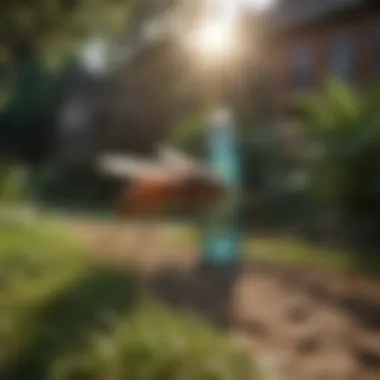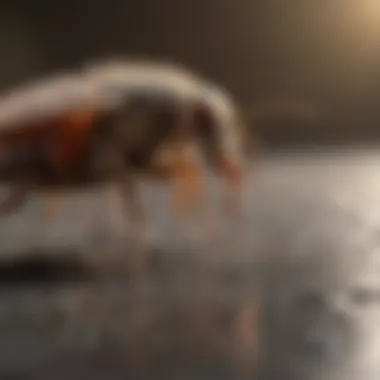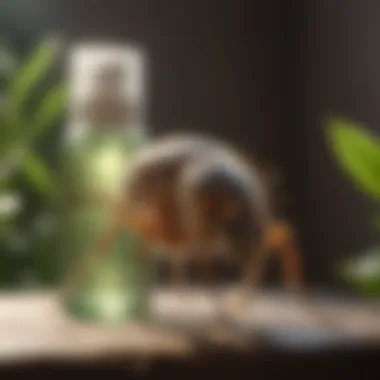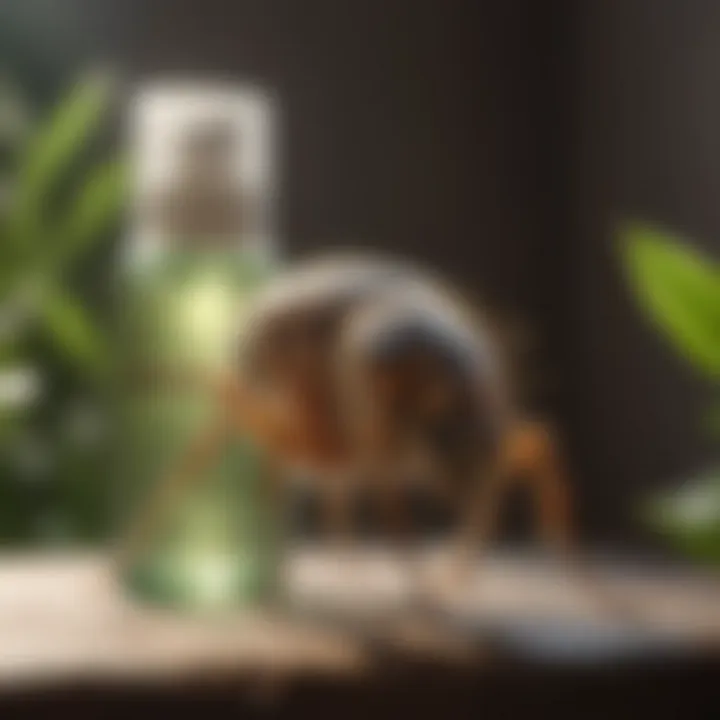Comprehensive Guide to All-Natural Flea and Tick Yard Spray


Intro
Fleas and ticks are more than just annoying pests; they can pose serious health risks to both humans and pets. As awareness grows around the use of synthetic chemicals in pest control, many are turning to natural solutions. This comprehensive guide offers valuable insights into all-natural flea and tick yard sprays, that is, how they work, what ingredients are effective, and safe application methods.
Understanding the nature of these pests is the first step towards effective control. Following this, we will explore various preventive techniques to keep your home and garden free from these nuisances. The latter part of this guide will introduce eco-friendly pest control solutions, showcasing natural remedies and their effectiveness. Enjoy discovering methods that add minimal impact to our environment, while ensuring comprehensive pest management.
Understanding Fleas and Ticks
Understanding fleas and ticks is crucial for effective pest management. Both of these parasites present unique challenges for homeowners and pets. They can cause discomfort, transmit diseases, and become a persistent problem if not addressed correctly. This section will outline their life cycles and the impact they have on both pets and humans.
The Lifecycle of Fleas
Fleas undergo a complex life cycle that includes four stages: egg, larva, pupa, and adult. Adult fleas lay eggs on their host or in their environment, often leading to an infestation in homes, yards, or on pets. These eggs can hatch within a few days under favorable conditions, such as warmth and humidity.
- Egg Stage: The white eggs are small, about 1mm in size, and can take anywhere from two days to two weeks to hatch, depending on the environment.
- Larva Stage: Once hatched, larvae feed on organic debris in their surroundings, including flea feces, which contains dried blood. This stage lasts around 5 to 20 days.
- Pupa Stage: After the larva stage, they spin cocoons and enter the pupal phase, where they can remain for weeks or even months until they sense a host nearby. This adaptability is a key reason fleas can be difficult to eliminate.
- Adult Stage: Adults can live for several months and require a blood meal to reproduce. Their ability to jump great distances facilitates their movement from host to host.
The Lifecycle of Ticks
Ticks also have a distinguished life cycle comprising four stages: egg, larva, nymph, and adult. Their need for blood at various life stages often brings them into contact with pets and humans, creating risks for disease transmission.
- Egg Stage: A female tick lays thousands of eggs in the spring, and these hatch into larvae in late summer.
- Larva Stage: The larvae typically feed on small animals like rodents before they molt into nymphs.
- Nymph Stage: Nymphs seek larger hosts, including pets and humans. Their bite is often painless, making them harder to detect, and this stage usually occurs in the spring.
- Adult Stage: Finally, after feeding, adult ticks can live for several years. They predominantly feed on larger mammals, such as deer or dogs, which are key vectors of Lyme disease and other infections.
The Impact of Fleas and Ticks on Pets and Humans
Fleas and ticks pose significant health risks for both pets and humans. For pets, fleas can cause irritation, allergic reactions, and lead to more serious conditions like anemia. Fleas may also transmit tapeworms if ingested during grooming.
Ticks, on the other hand, present even more serious dangers. They can transmit diseases such as Lyme disease, Rocky Mountain spotted fever, and babesiosis, which can have severe health implications. Symptoms can range from mild fever to life-threatening conditions, underscoring why vigilant monitoring and control are essential.
"Training your eyes to spot these pests can save your pet from unnecessary harm and aid in early prevention efforts."
In summary, understanding the life cycles and impacts of fleas and ticks is fundamental to developing effective pest control strategies. Each stage of their life cycle presents different opportunities for management and prevention. By recognizing these details, homeowners can make informed decisions toward creating a healthier living environment.
Natural Methods of Pest Control
Natural methods of pest control have gained significant attention in recent years. They present a viable alternative to chemical pesticides, offering various benefits that are worthwhile to consider. With growing concerns over environmental health and human safety, adopting natural solutions for pest management is essential. This section delves into what makes natural pest control methods appealing and effective.
Benefits of Natural Solutions
Natural solutions contribute to ecological sustainability in ways that chemical alternatives often cannot. They tend to have a lower environmental footprint, leading to less pollution in soil and waterways. Moreover, these solutions usually rely on plant extracts or other biodegradable substances that minimize residue and reduce health risks. Users often report feeling more comfortable with natural products, especially in spaces frequented by children and pets.
Another significant advantage is the potential for fewer side effects when used as directed. Unlike some chemical pesticides, natural solutions are often less toxic, meaning they are safer for non-target organisms. Also, opting for natural methods can foster a healthier garden ecosystem. Beneficial insects, such as bees and ladybugs, are less likely to be harmed, which is crucial for maintaining biodiversity.
Therefore, the decision to utilize natural pest control can be seen not only as a move toward personal safety but also as a commitment to protecting the environment.
Common Ingredients in Natural Yard Sprays
Creating effective natural yard sprays often involves common household ingredients that serve specific functions. Understanding these ingredients provides insight into their roles in pest management.
Essential Oils
Essential oils have become widely recognized for their pest-repelling properties. Oils such as lavender, peppermint, and eucalyptus can disrupt the sensory perception of pests, making it difficult for them to locate hosts or food sources. A key characteristic of essential oils is their concentrated nature; a little goes a long way in a formulation. This potency makes them popular in natural pest control solutions. However, it is important to note that while essential oils are effective, they can sometimes cause skin irritation in sensitive individuals, demanding careful usage.
Vinegar
Vinegar is another common ingredient in natural pest sprays. Its acidic nature helps repel certain pests while also serving as a cleaning agent for the yard. People frequently use white vinegar or apple cider vinegar for their pest control sprays. The key characteristic of vinegar is its availability and affordability. Most households already have it on hand, offering an easy entry point for those new to natural pest control. However, while it can deter pests, it may also affect beneficial insects if misused, so caution is required during application.


Citrus Extracts
Citrus extracts, derived from fruits like oranges and lemons, are also effective in repelling fleas and ticks. The strong scent that humans often find pleasant can be overwhelming to pests. This characteristic makes citrus extracts a beneficial choice for natural yard sprays. Additionally, citrus-based products are usually biodegradable and environmentally safe. However, the efficacy can vary depending on the concentration and application frequency, meaning they may need to be reapplied regularly for maximum effectiveness.
Herbs and Spices
Herbs and spices, such as rosemary and cayenne pepper, are not only staples in the kitchen but also serve effective pest-repelling roles. Their natural compounds can deter insects while adding a layer of fragrance to sprays. A key advantage of using herbs and spices is their multifunctional nature; they can be grown in gardens for culinary use and pest control alike. However, these ingredients may be less potent than essential oils or vinegar, requiring larger quantities or more frequent applications to achieve desired results.
"Natural pest control offers a holistic approach to managing fleas and ticks. It balances effectiveness with safety for both humans and the environment."
In summary, natural methods of pest control embrace a range of ingredients that not only prove effective against pests but also align with environmental health standards. The benefits of using natural solutions are clear, encompassing both personal safety and ecological responsibility.
Formulating Your Own All-Natural Spray
Creating an all-natural flea and tick yard spray is a practical solution for pest control. Natural sprays can be effective without relying on harmful chemicals. Formulating these sprays allows individuals to use safe ingredients that are less likely to harm pets or beneficial insects. Additionally, DIY methods can be more cost-effective compared to commercial alternatives. This section offers clear guidance on how to select the right components and blend them effectively for the best results.
Selecting Ingredients
Choosing suitable ingredients is crucial for an effective yard spray. The right blend affects both efficacy and safety. Essential oils, vinegar, citrus extracts, and various herbs and spices are common choices in natural formulations. Each ingredient carries its own unique properties that contribute to repelling fleas and ticks. For instance, essential oils such as lavender and peppermint can deter pests due to their strong scents. Vinegar is known for its acidic properties, which can also repel insects. It's important to consider the potency and any potential allergies when selecting these ingredients.
The Mixing Process
Understanding how to mix the ingredients properly is just as vital as selecting them. The way you combine them can significantly impact the effectiveness of the spray. Each method in the mixing process contributes to the solution's potency and application ease.
Proportions and Ratios
Getting the proportions and ratios right is essential in creating a balanced spray. For instance, a typical recommendation is to mix essential oils at a ratio of 3 to 5 percent of the total volume. This concentration is effective without being overpowering. A common choice is to utilize one cup of water with several drops of essential oil. This careful balance ensures the mixture maintains a high level of effectiveness while remaining safe for the environment and pets. However, using too much oil can lead to irritation for pets and humans alike.
Combining Techniques
Combining techniques can enhance the mixing process. One option includes shaking the mixture vigorously to create an emulsion. This ensures that the oils blend evenly with the water base. Alternatively, using a blender can achieve a well-integrated spray. A big advantage of these techniques is that they help prevent separation, allowing for consistent application. However, these techniques may require more effort and time.
Storage Recommendations
Proper storage of the mixed spray is necessary to maintain its effectiveness. It is advisable to keep the spray in dark glass bottles to protect it from light, which can degrade essential oils. Store the spray in a cool, dark area, avoiding direct sunlight and heat sources. If stored correctly, the spray can last for several weeks. A unique feature of natural sprays is that they do not contain preservatives, which makes this aspect of storage even more critical. Attention to these details plays a significant role in prolonging the potency and shelf life of your homemade flea and tick spray.
Application Techniques for Yard Sprays
Application techniques are crucial for the effectiveness of all-natural flea and tick yard sprays. Proper application not only maximizes their impact but also ensures safety for both humans and the environment. Understanding when and how to apply these sprays can greatly influence their success against these pests.
Timing and Frequency of Application
Timing is essential for the success of flea and tick yard sprays. Applying the spray at the right time increases its effectiveness. Early spring and late summer are typically the best periods for treatment because these months align with the active stages of fleas and ticks. Regular application every two to four weeks can maintain control over these infestations. Moreover, factors such as weather can play a significant role. Rain can wash away sprays, so it is advisable to apply before a forecasted dry period.
Methods of Application
Spray Bottles
Using spray bottles for yard sprays is a common method due to its simplicity. This direct method allows for targeted application on plants and areas with high pest activity. The main benefit of spray bottles is that they require no additional equipment, making them an accessible choice for many homeowners. However, the coverage may be limited compared to other methods. For small gardens or specific areas, spray bottles offer precision.
Garden Sprayers
Garden sprayers are another practical option for applying yard sprays. These devices are designed for larger areas, allowing for quicker application. The key characteristic of garden sprayers is their capacity to hold more liquid, enabling extensive coverage in a short time. Many gardeners favor this method because it reduces the physical effort needed to treat larger yards. However, they require maintenance to ensure effective operation, which might deter some users.
Foggers


Foggers are advanced tools for applying natural sprays over extensive spaces. They disperse the spray in tiny droplets, creating a mist that can reach difficult areas. This method is particularly effective in dense foliage or larger yards. Foggers are favored for their efficiency; they can quickly cover significant areas without much effort. Nonetheless, they can be more expensive than other methods and may require more practice to use effectively. Users should be aware of wind conditions, as this can affect spray distribution.
By understanding these application techniques, homeowners can enhance the effectiveness of their flea and tick control efforts while minimizing any potential harm to the environment.
Efficacy of Natural Flea and Tick Sprays
The efficacy of natural flea and tick sprays is a crucial aspect of this article. These sprays offer an alternative to conventional treatments, appealing to housewives and homeowners seeking effective pest control without harmful chemicals. The understanding of how these natural solutions work, their benefits, and their practical implications can help in making informed decisions for pest management.
Several factors contribute to the effectiveness of natural flea and tick sprays. Firstly, the choice of ingredients plays a significant role. Many natural sprays utilize essential oils, vinegar, and other organic components known for their pest-repelling qualities. Each ingredient within these formulations has been researched for its ability to deter fleas and ticks while being safe for humans and pets.
When evaluating the efficacy of these products, it is essential to consider their persistence in the environment. Natural ingredients often break down more rapidly than chemical alternatives. Therefore, their effectiveness may require more frequent applications. Understanding this trade-off is essential when adjusting pest management strategies.
Moreover, the application technique influences the spray’s effectiveness. Proper coverage and timing can determine how well the active ingredients work against pests. Homeowners should be aware of the need to follow specific guidelines to maximize the benefits of these sprays.
"Environmental safety should not compromise the effectiveness of pest control methods." This highlights the need for a balance between ecological impact and overall pest management success.
Scientific Studies and Findings
Research into the efficacy of natural flea and tick sprays has yielded varied results. Scientific studies have investigated specific ingredients and their effectiveness against pests. For instance, essential oils like lavender and peppermint have shown promising results in repelling fleas and ticks. Research highlights that some essential oils possess insecticidal properties that can disrupt the lifecycle of these pests. Furthermore, comparative analyses reveal that while natural sprays may refrain from providing as immediate results as synthetic chemicals, they offer sustainable pest management solutions.
Studies published in peer-reviewed journals frequently discuss the role of plant extracts in pest inhibition. These studies reveal that while there is potential in using all-natural sprays, continued research is necessary to fully understand their long-term effectiveness compared to conventional products.
User Experiences and Testimonials
User experiences and testimonials provide a practical insight into the efficacy of natural flea and tick sprays. Many housewives and homeowners report positive outcomes using natural solutions. They often emphasize improvements in pest populations after adopting these sprays. Most anecdotes revolve around ease of use, pleasant scents, and peace of mind regarding health implications.
However, some users note that results may vary based on application frequency and ingredient concentrations. Beginners might find difficulties in determining the right dosage or coverage needed for adequate protection. Users occasionally document this variability in effectiveness, underscoring the importance of following specific guidelines and adjusting usage based on findings.
Overall, feedback tends to be favorable, reinforcing the approach these natural sprays promote towards environmental responsibility and health-conscious living.
Commercial Alternatives to Natural Sprays
When considering pest control in your yard, exploring commercial alternatives to natural sprays becomes essential. These products typically provide solutions that some homeowners may prefer over DIY methods. Understanding their components, efficacy, and the implications they have on health and the environment is vital for making informed decisions. Many individuals seek commercial options for reasons like convenience, consistency, and reliable results. However, scrutiny is necessary to evaluate these products, especially concerning safety and environmental impacts.
Evaluating Natural Products on the Market
In today's market, numerous natural pest control products claim to be effective against fleas and ticks. When evaluating these options, it is important to check the ingredients thoroughly, even if they are labeled as natural. Look for products featuring organic or sustainably sourced components. Many commendable brands utilize essential oils, plant extracts, and other non-synthetic ingredients.
- Label Inspection: Always read the labels for active and inactive ingredients. Understanding what is in these products ensures you choose what fits your pest control philosophy.
- Certification: Seek products that have certifications indicating they are safe for use around children and pets, like the EPA’s Safer Choice label. This provides some assurance regarding their safety compared to more industrial chemicals.
- Customer Reviews: Feedback from other consumers offers real-world insights into the product's effectiveness. Look for comprehensive reviews that discuss both positive and negative experiences.
Comparative Analysis: Natural vs. Chemical Options
A comparative analysis between natural and chemical products establishes an understanding of their different functionalities and impacts.
- Efficacy: Often, chemical sprays can act more rapidly in killing pests. However, many natural sprays have shown effectiveness, particularly when applied consistently. The speed and duration of relief can vary significantly between these two categories.
- Environmental Impact: Natural sprays tend to have a smaller ecological footprint. They are less likely to harm beneficial insects or contaminate water sources. On the other hand, chemical options often raise concerns regarding toxicity to non-target species and long-term ecological consequences.
- Health Safety: Household members and pets' safety is paramount. Natural options often present a safer alternative in homes with children and pets. Chemicals may pose health risks upon exposure, leading to allergies or respiratory issues.
In summary, weighing the options between natural and commercial alternatives is complex. It is paramount to analyze specific products, understanding their ingredients, and weighing their respective benefits and drawbacks. This careful examination allows homeowners to choose an appropriate pest management solution tailored to their values and circumstances.
Safety and Environmental Considerations
The use of all-natural flea and tick yard sprays has gained popularity due to their perceived safety for both humans and the environment. Understanding the safety and environmental considerations surrounding these products is crucial, especially for homeowners who prioritize a healthy living environment. The choice of ingredients, the potential impacts on non-target organisms, and the overall ecological balance are all factors to consider.
Human Health Considerations
When formulating or applying natural flea and tick sprays, it is essential to prioritize human health. Natural ingredients, such as essential oils, offer effective pest control while minimizing toxic exposure. Common essential oils like lavender and eucalyptus have natural insect-repelling properties; however, it is important to use them correctly to avoid allergic reactions or irritations.


Before using any product, homeowners should evaluate their own sensitivities. Always conduct a patch test for new ingredients on the skin to check for potential reactions. Additionally, ensure that children and pets are kept away during application to prevent accidental exposure. It is advisable to ventilate the area post-application as well. By adhering to safety guidelines, individuals can effectively reduce the risks associated with both chemical and natural sprays. Ultimately, informed choices reflect a commitment to protecting health within the household.
Protecting Beneficial Insects
Eco-friendly pest control not only aims to eliminate harmful fleas and ticks but also focuses on protecting beneficial insects that are vital to ecosystem health. Common beneficial insects include ladybugs, bees, and predatory wasps, all of which play significant roles in maintaining balance within gardens and yards.
Using harsh chemicals can create a negative impact on these populations, leading to unintended consequences such as reduced pollination and increased pest outbreaks. Therefore, when selecting all-natural sprays, the choice of ingredients is critical. Some essential oils, while effective against pests, can disrupt the lifecycle of beneficial insects if used excessively.
Homeowners should consider the timing of application—sprays should be applied during periods when beneficial insects are least active. For instance, avoiding application during blooming periods helps safeguard pollinators. Moreover, adopting a targeted approach with spot treatments can minimize direct exposure to non-target species.
Integrating Yard Spray into a Pest Management Plan
Integrating an all-natural yard spray into a larger pest management plan is essential for achieving long-term effectiveness in flea and tick control. This step helps not only in managing the immediate problem but also in preventing future infestations. By utilizing natural sprays, homeowners can reduce their reliance on chemical treatments, contributing to a healthier environment for both the family and local wildlife.
The process of integrating includes several key elements.
Creating a Comprehensive Plan
To create a successful pest management plan, various factors must be evaluated. First, it is important to assess the specific needs of the yard. Each setting can vary significantly based on climate, geography, and the presence of pets or children. Homeowners should consider the following aspects:
- Evaluate the frequency of flea and tick occurrences in the area.
- Identify any existing barriers that limit pest movement.
- Determine high-risk zones in the yard, such as shaded areas or places near standing water where ticks thrive.
Once an assessment is completed, a combination of yard spray applications and preventive measures can be developed. This holistic approach ensures that the yard remains less hospitable to pests over time.
A clear schedule for spray applications can also be established. Regularly scheduled treatments can disrupt the pest lifecycle and significantly reduce populations.
Regular Maintenance and Monitoring
Monitoring the effectiveness of the yard spray plays a critical role in pest management. Homeowners should routinely check for new signs of flea and tick activity after applying sprays. This involvement can include:
- Observing pets for signs of discomfort or itching.
- Checking grassy areas and shrubs for visible pests or their eggs.
- Modifying spray application techniques if results do not meet expectations.
Regular maintenance also includes re-evaluating the conditions of the yard. Environmental factors, like weather, can influence the efficacy of natural sprays. For instance, rain may wash away products, requiring reapplication sooner than scheduled.
Effective pest management is a cycle of assessment, application, and adaptation.
By maintaining an active role in monitoring and adjusting strategies as needed, homeowners can ensure high levels of effectiveness from their all-natural yard sprays and create a sustainable approach to pest control.
Ending and Future Perspectives
The topic of natural pest control, particularly through all-natural flea and tick yard sprays, holds noteworthy significance today. The rising awareness around chemical pesticide use, coupled with the emphasis on maintaining ecological balance, has driven many homeowners to consider alternative solutions. This article has outlined the formulation, application, and safety of these natural sprays, showcasing their relevance in promoting healthier living spaces for families and pets alike.
Understanding the methods in crafting these sprays empowers individuals to take ownership of their pest management strategies. Furthermore, it highlights the benefits associated with such practices. For instance, natural solutions tend to mitigate adverse side effects on non-target species, thus protecting beneficial insects that play a critical role in maintaining the ecosystem.
In addition to environmental benefits, the economic aspect cannot be overlooked. Creating your own pest control solutions can lead to cost savings compared to commercial chemical products. These factors together emphasize the necessity of adopting natural alternatives within home management approaches.
Looking forward, the exploration of innovative techniques in pest management broadens the possibilities of natural solutions becoming more effective. As new methods emerge, consumers can expect better formulations that integrate scientific findings with traditional knowledge. This synergy could lead to groundbreaking ways to manage pests sustainably while ensuring the health and well-being of the environment.
"Innovations in pest management not only address current challenges but also pave the way for a sustainable future in how we interact with our shared environment."
As we venture into a future of heightened awareness regarding environmental issues, approaches to pest management must adapt to these changes. Homeowners will increasingly need to reconsider their choices, adopting sustainable practices that reflect their values and priorities. In doing so, individuals can contribute to a greater movement that prioritizes the health of our planet.
Final Thoughts on Natural Pest Control
Natural pest control represents a proactive approach to managing fleas and ticks without harming the environment. With an increasing number of individuals opting for eco-friendly options, the movements towards sustainable practices are clear. Utilizing all-natural yard sprays is not merely about achieving pest eradication; it's entwined with a broader commitment to ecological stewardship. Homeowners can take pride in ensuring their yards are safe environments for both their families and local wildlife.
Looking Ahead: Innovations in Pest Management
The realm of pest management is steadily evolving. Ongoing research into natural ingredients holds the potential for more effective solutions. New advancements could optimize the efficacy of natural sprays, making them more accessible and user-friendly. For instance, the integration of smart technology like application apps can help in determining the best times and methods for application, enhancing the overall effectiveness of pest control strategies. As these innovations come to fruition, they will encourage greater acceptance and use of natural products among consumers.
The future of pest management not only rests on minimizing chemical dependencies but also on creating harmony between human activities and nature. A commitment to continuous learning and adaptation will empower individuals to participate in this shift, ultimately fostering a healthier ecosystem.



